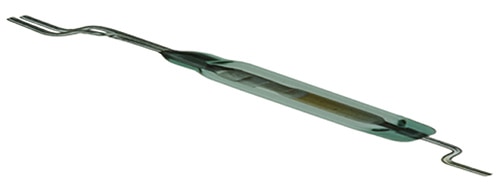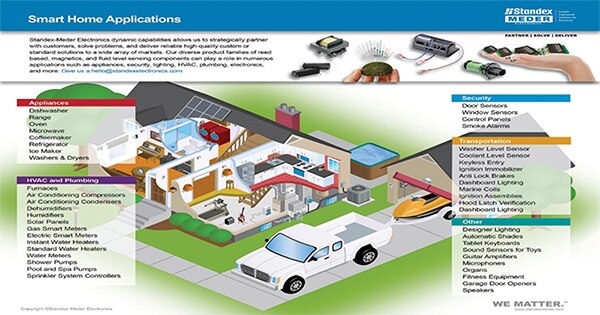Reed Series Products Deliver Simplicity, Cost Savings in Smart Home Worlds
2015-10-22
Standex-Meder Electronics reed relays, switches, and sensors play a vital role in the switching of on and off smart home system applications. The reed switch itself provides a base of energy conservation stemming from custom design and solutions. Partnering with DigiKey, we provide our reed series product lines via a global distribution platform.
Smart Home integration within sensory products seems to be key, and not just a niche market. While so many companies are coming out with smart home controlled HVAC systems, security locks and doors, amongst other new technology concepts that have come to fruition, the need to manage the volume and velocity in which orders come in, maintains priority.
Figure 1: Potential smart home applications for Standex-Meder products.
The power of Smart Home integration
The basic building block for a “Smart Home” is an internal control system within the home that is internet addressable and is capable of interfacing with all of the existing major home systems (HVAC, electrical, fire, and security systems). In older homes some of these existing systems will need to be upgraded so they are up-to-date, or will need to be replaced.
In engineering technologies and manufacturing, “efficiency” is a key term played off of, as companies race to provide better cost effective, more energy efficient components. The different reed series’ lines SME offers help mitigate the ever-changing world of smart home applications.
For example, Standex-Meder worked with a customer in designing a custom solution and product to fit power consumption needs with our MK24 Reed Sensor – a part DigiKey carries -- utilized in on/off control switches. This particular reed sensor, while larger than a Hall or GMR sensor, allows a substantial amount of built-in power switching capabilities from typical 10 VA, and switching voltage max of 30 V.

Figure 2: Standex-Meder MK24 reed sensor.
The ability to detect input and outputs, automatic on/off switching to reduce energy costs in smart HVAC systems, and thermostat controls is still pressing forward with technological advances.
The majority of SME reed sensors offered in the Dig-Key lineup have built-in influx concentrators as the external and internal parts of the reed sensor leads are manufactured from NiFe wire and act as antennas -- searching for the flux generated by the permanent magnet. This enables these external switch leads to be formed and fit in end-applications in a manner that allows them to grab more of the said magnetic flux, similar to how a keeper functions on a permanent magnet.
You can now turn on your thermostat in your house from your smartphone at work with a push of a button. Smartphone applications have opened up a plethora of capabilities for manufactures such as Standex-Meder Electronics in partnership with DigiKey. Not only is the digital world capacitating on ease of use and usability, but energy efficiency is a huge take away, especially in the line of green product segments that have taken off.
Security locks use reed switches, reduce energy cost
Reed sensors are widely used in security and access lock systems for medical, school, and other various facilities. Now homes have come into play, as you can lock your home from your computer, your car, or even your smartphone. Since the reed switch draws no power, it is ideal for many of the newer security applications in these markets that use battery-powered devices with wireless controllers.
Examples of electronic access solutions (EAS) developed by Standex-Meder include a security mortise lock printed circuit board (PCB) or assembly for one of the largest global suppliers of intelligent lock and security solutions. The assembly itself includes surface-mount reed sensors and provided a solution to challenges faced. For instance, the application had a large amount of metal, which can create interference and sensitivity. Parts carried by DigiKey for this solution, include the MK23-90 and MK23-66 Reed Sensor series.

Figure 3: Standex-Meder MK23-90 reed switch series.
In the case of penal systems and other high-security facilities, the use of technology and cost savings can be justified in the sense that areas need to be cordoned. Evidence lockers and holding areas all need to have secure electronic locks to satisfy federal and state safety and security protocols. Custom reed-based sensors such as the MK03 carried by DigiKey help address these concerns.
Standex-Meder looks at emerging technologies to fuel design
Technology is ever-changing, and with that Standex-Meder realizes it must always look forward. Our engineers are ready to fuel this with custom and standard designed products. Smart Homes will continue to evolve and reed sensors, switches, and relays will be looked at to play a more robust and involved role in innovative yet cost and energy efficient electronics.
While technology is moving forward, SME also realizes it needs to capitalize on making items smaller than standard switches and sensors. Our new Hall Sensor product line (MH04, MH21), while newer in design and production, allows for low power consumption, consistent activation points, and still maintains reliability over wide temperature ranges and rugged environments.

Figure 4: Standex-Meder SME micro-power Hall effect sensors.
These new micro-versions operate on 3 V battery supply, while requiring only 5 μA, which compares to an industry average of 5 mA. These new smaller sensors also come in a variety of sizes and custom options to including: switch, latch, analog, and angular.
免责声明:各个作者和/或论坛参与者在本网站发表的观点、看法和意见不代表 DigiKey 的观点、看法和意见,也不代表 DigiKey 官方政策。









 中国
中国